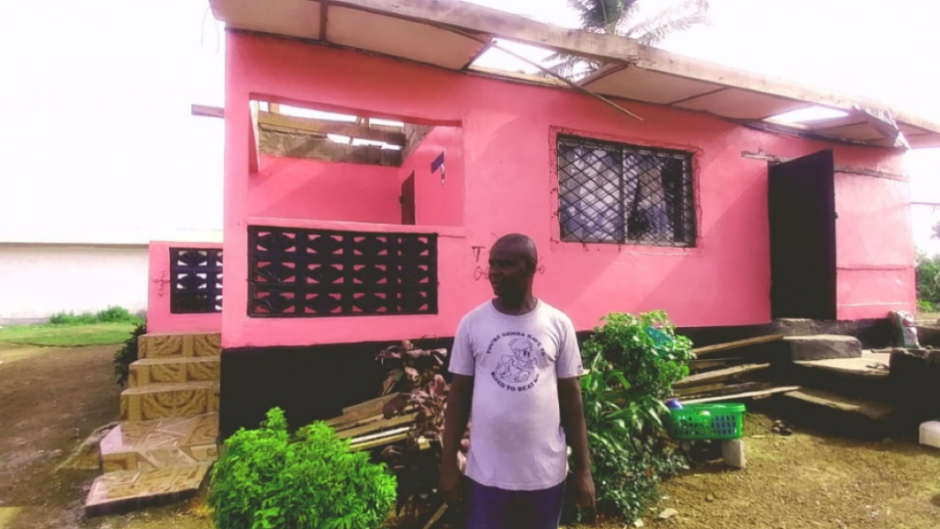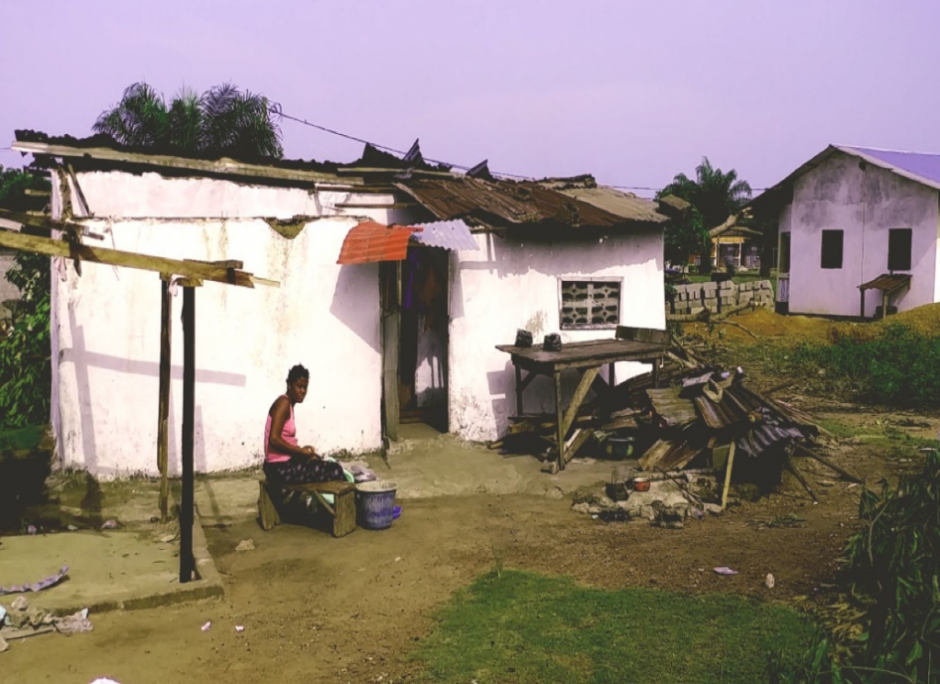
BARNESVILLE – David Wesseh, a resident of Kebbah, appears confused after his two houses were unroofed by a heavy storm. Wesseh, his wife and his seven children are being accommodated by friends not far from where his roofless houses stand, but he is worried that he and his family could catch coronavirus.
There have been no confirmed cases of the disease in Barnesville but healthcare workers are tracing two people in the township who came in contact with a patient of the disease.
“I feel we’ve been hit by a double sword,” he tells FrontPage Africa. “We are worried about food and the repairing of our houses and at the same time fearing contracting the virus.”
The rainstorm that tore off the roofs of Wesseh’s houses affected 199 other homes in Barnesville last month. It destroyed 150 homes in the Thinkers’ Village area, displacing 300 people. Days later, another rainstorm damaged 85 houses in Maryland and 65 in Bong County. Even this week, many buildings were ravaged in Nimba. In total, 3,845 people have been affected by rainstorm in five counties since Liberia reported its first coronavirus case, according to the National Disaster Management Agency.
Coronavirus is surging in Liberia, with 20 deaths, 178 confirmed cases and 850 contacts recorded as May 7. Except for Bong and Lofa, all of the six counties that have experienced storm have all recorded cases. Montserrado is the epicenter of the pandemic in Liberia, with 160 cases. Nimba has seven cases, Margibi six and Maryland one case.
Health authorities are now making room for more natural disasters, fearing extreme might contribute to the spread of the disease among displaced people. President George Weah has included building material stores on the list of businesses that are to remain open during this state of emergency.
“We did not anticipate that we would have had an outbreak before a disaster, which we normally plan for,” says Amos Gborie, manager of NPHIL’s emergency center. “The storm situation has now caused us to broaden our overall strategy in dealing with the outbreak.”
NPHIL is increasing its engagement with the national disaster management team and also activate civilian cells in communities that will be affected by disaster, Gborie continues. “The objective of this is to increase active contact-tracing of high and low-risk people for possible diagnosis and prevent the possible spread of the virus.”

Liberia has experienced extreme weather each year of the last decade, mainly due to climate change. Montserrado, Grand Bassa and southeastern counties frequently suffer sea erosion. Margibi combats continued flooding. Bong bears rainstorms repeatedly. And Lofa battles perennial bushfire.
With the rains delaying to arrive this year, some environmentalists fear the worst is yet to come. In July 2018, massive flooding caused by heavy rainstorm affected nearly 30,000 people, one of the worst recorded in the country’s history.
“Many people will get affected with the coronavirus if nothing is done to prevent the most vulnerable population of our country,” says Jerry Garteh, science and conservation coordinator at Society of the Conservation of Nature in Liberia (SCNL). Majority of the country’s population is already struggling with poor infrastructure, and that rainstorm and flooding result into massive displacement will worsen their situation and limit national resources in preventing the spread of the Coronavirus, according to him.
No Relief for National Storm Victims
The situation has also shed light on the ineffectiveness of the disaster agency.
The disaster agency has always struggled to get funding since its establishment in 2016. It runs an annual budget of US$800,000—just enough to pay salaries—less than a quarter of US$4 million it needs to effectively perform its duties, according to the agency’s Deputy Executive Director for Operations.
“If we had the money, we would work through the small, medium enterprises with other line agencies to ensure we carry out surveillance, monitoring, and robust contact tracing within the population of disaster affected communities,” Tamba says. “To be effective in handling these large disasters as they are coming, we need to increase budgetary support.”
Montserrado District No. 11 Representative Richard Koon shares Tamba’s opinion, saying there is a need to strengthen the agency’s preparedness. “I am afraid that if we do not put in the right steps, and implement them, more people could get infected with the virus in the raining season,” Representative Koon says. “The storm disaster has exposed a potential loophole for Covid-19 to spread.”
The Liberia National Red Cross Society, which has aided victims of flood and rainstorm in the past, has funding problems as the disaster agency. It cannot help victims like Wesseh because it is overwhelmed with the coronavirus response, says its Communication Director Oniel Bestman.
Wesseh is concerned about hunger as he has fear for the pandemic. The rainstorm spoiled more than three bags of rice he had to take his family through the lockdown, which lasts until Saturday. A street peddler, that means he is unable to sell, and he does not have money to repair his houses. “I am kindly calling on people of goodwill to come and help us. I am in a difficult situation.”
This story was a collaboration with New Narratives as part of our Land Rights and Climate Change Reporting Project. Funding was provided by the American Jewish World Service. The Funder had no say in the story’s content.
